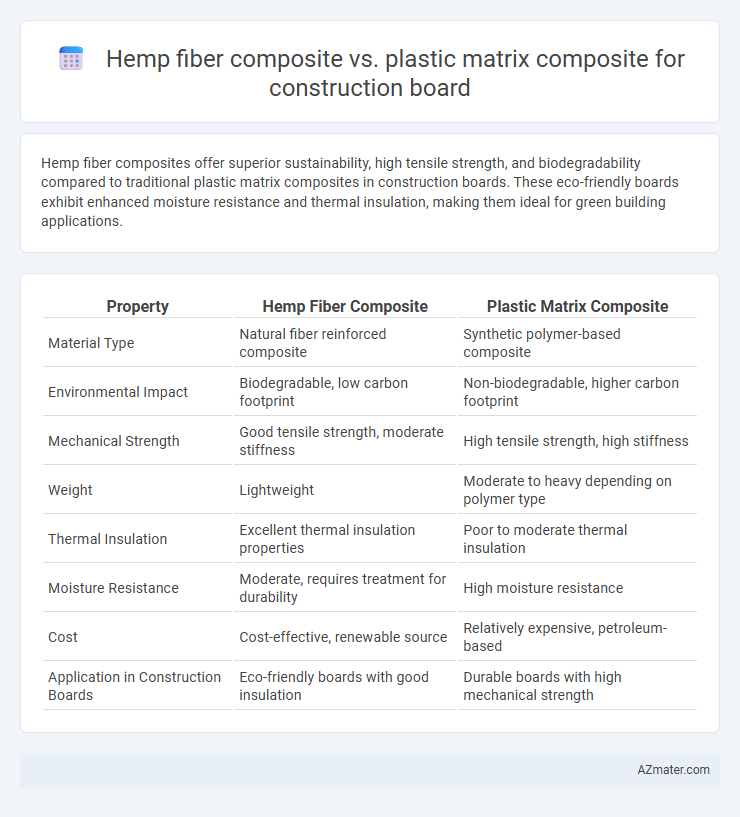Hemp fiber composites offer superior sustainability, high tensile strength, and biodegradability compared to traditional plastic matrix composites in construction boards. These eco-friendly boards exhibit enhanced moisture resistance and thermal insulation, making them ideal for green building applications.
Table of Comparison
| Property | Hemp Fiber Composite | Plastic Matrix Composite |
|---|---|---|
| Material Type | Natural fiber reinforced composite | Synthetic polymer-based composite |
| Environmental Impact | Biodegradable, low carbon footprint | Non-biodegradable, higher carbon footprint |
| Mechanical Strength | Good tensile strength, moderate stiffness | High tensile strength, high stiffness |
| Weight | Lightweight | Moderate to heavy depending on polymer type |
| Thermal Insulation | Excellent thermal insulation properties | Poor to moderate thermal insulation |
| Moisture Resistance | Moderate, requires treatment for durability | High moisture resistance |
| Cost | Cost-effective, renewable source | Relatively expensive, petroleum-based |
| Application in Construction Boards | Eco-friendly boards with good insulation | Durable boards with high mechanical strength |
Introduction to Composite Materials in Construction
Hemp fiber composites offer a sustainable alternative to traditional plastic matrix composites in construction boards by leveraging natural fibers with high tensile strength and low weight. Plastic matrix composites, commonly made from thermosetting resins like epoxy or polyester, provide excellent durability and moisture resistance but pose environmental challenges due to non-biodegradable components. The integration of hemp fibers enhances biodegradability and thermal insulation properties, positioning hemp fiber composites as environmentally friendly and efficient materials for modern construction applications.
Overview of Hemp Fiber Composite Boards
Hemp fiber composite boards represent an eco-friendly alternative to traditional plastic matrix composites in construction, offering superior biodegradability and reduced carbon footprint. These boards provide high tensile strength, excellent thermal insulation, and enhanced moisture resistance due to the natural lignocellulosic structure of hemp fibers. Integration of hemp fiber composites in building materials promotes sustainable construction practices by lowering reliance on petroleum-based plastics and improving indoor air quality through low VOC emissions.
Understanding Plastic Matrix Composites
Plastic matrix composites (PMCs) consist of a polymer resin as the continuous phase reinforced by fibers such as glass, carbon, or natural hemp fibers to enhance mechanical properties and durability in construction boards. PMCs offer superior strength-to-weight ratios, corrosion resistance, and design flexibility compared to traditional materials, making them ideal for structural applications requiring longevity and reduced maintenance. Understanding the interaction between the plastic matrix and fiber reinforcement is critical for optimizing load transfer, moisture resistance, and thermal stability in construction board manufacturing.
Material Properties: Strength and Durability
Hemp fiber composites offer high tensile strength and excellent impact resistance, making them a sustainable alternative to traditional plastic matrix composites in construction boards. Their natural fiber structure enhances durability by providing better resistance to cracking and environmental degradation compared to many synthetic plastics. Plastic matrix composites generally provide superior moisture resistance and consistent mechanical properties, but often lack the eco-friendly advantages and biodegradability of hemp fiber composites.
Environmental Impact and Sustainability
Hemp fiber composites significantly reduce carbon footprint compared to plastic matrix composites, as hemp is a rapidly renewable resource that sequesters CO2 during growth. Hemp composites exhibit superior biodegradability and lower toxic emissions in production and disposal stages, enhancing environmental sustainability. Plastic matrix composites rely on fossil fuels and contribute to persistent microplastic pollution, making hemp fiber composites a more eco-friendly alternative for construction boards.
Cost Analysis and Economic Viability
Hemp fiber composites offer a cost-effective alternative to plastic matrix composites for construction boards, with raw materials sourced from rapidly renewable hemp crops, reducing dependency on petroleum-based plastics. Manufacturing costs tend to be lower due to simpler processing techniques and less energy-intensive production, enhancing the overall economic viability for large-scale construction applications. Lifecycle cost analysis shows hemp composites provide better insulation and durability benefits, potentially reducing maintenance expenses and increasing long-term savings compared to conventional plastic composites.
Installation and Workability on Site
Hemp fiber composites offer superior workability on site due to their lightweight nature and flexibility, making cutting and fastening easier compared to rigid plastic matrix composites. Installation processes benefit from hemp's natural breathability and moisture regulation, reducing the risk of mold and improving indoor air quality within construction boards. Plastic matrix composites, while offering higher strength, often require specialized tools and handling due to their stiffness and potential off-gassing, impacting ease of installation and worker safety.
Resistance to Moisture and Decay
Hemp fiber composites exhibit superior resistance to moisture and decay compared to traditional plastic matrix composites, owing to their natural lignin and cellulose content that enhances breathability and reduces water absorption. Plastic matrix composites often suffer from long-term degradation when exposed to moisture due to hydrolytic instability of polymers such as polypropylene or polyvinyl chloride. Construction boards incorporating hemp fibers demonstrate increased durability and mold resistance in humid environments, making them a sustainable alternative with improved performance in moisture-prone applications.
Long-Term Performance and Maintenance
Hemp fiber composites exhibit superior long-term performance and reduced maintenance requirements compared to plastic matrix composites in construction boards due to their natural durability, resistance to moisture, and biodegradability. The natural fibers in hemp composites enhance thermal insulation and mechanical strength over time, minimizing degradation and the need for frequent repairs. Conversely, plastic matrix composites are prone to environmental stress cracking and UV degradation, leading to higher maintenance costs and potential structural integrity loss.
Future Trends in Construction Composite Boards
Hemp fiber composites demonstrate superior sustainability and biodegradability compared to traditional plastic matrix composites, aligning with the growing demand for eco-friendly construction materials. Advances in hemp fiber treatment and resin compatibility are enhancing mechanical strength and moisture resistance, making hemp-based boards increasingly viable for structural applications. Future trends indicate a shift toward hybrid composites that integrate hemp fibers with bio-based or recycled plastic matrices to optimize performance while minimizing environmental impact.

Infographic: Hemp fiber composite vs Plastic matrix composite for Construction board
 azmater.com
azmater.com